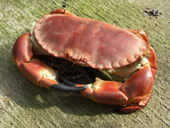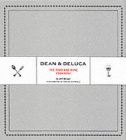
UK/Ireland
•Canada/USA
________________________________________________________________________

eat
crab
In sandwiches, with
pasta, in salads, with chilli - there are a multitude of ways to enjoy
this most versatile of seafoods. White crab meat (from the claws) rivals,
or exceeds, lobster for flavor and succulence and needs very little fiddling
with to create masterful dishes such as Crab in Ginger Sauce
(see PICK OF THE RECIPES).
HISTORY
Crabs first evolved in the Jurassic period (the horseshoe crab dates back over 200 million years). They have been caught and eaten throughout human history.
BIOLOGY
Crabs are crustaceans belonging to the order Decapoda (which includes lobsters and prawns). There are around 4,500 species of crab, ranging in size from the 5mm wide pea crab to the Japanese spider crab with a leg span in excess of 2m.
NUTRITION
Crab is a good source of a number of trace minerals including selenium, which counteracts cancer and chromosome damage as well as increasing our resistance to viral and bacterial infections. It contains useful amounts of B vitamins, iron and zinc.
TIPS
BUYING
Purchasing a live crab will ensure maximum freshness. You can ask your
fishmonger to kill it and this is probably more humane than dropping it
in boiling water. Whole cooked crabs or fresh crab meat from a trusted
supplier are perfectly adequate alternatives.
STORING
Live or freshly killed raw crab should be refrigerated and cooked on the
day of purchase. Cooked crab meat will be fine in the fridge for 3 or
4 days and can be frozen.
PREPARING
Preparing a crab isn't as messy or difficult as you might imagine. Cook
raw crabs by boiling - 20 minutes for crabs up to 1kg and 10 minutes per
kg after that. Allow the crab to cool and then twist off the claws and
legs. Knock the underside of the body on the chopping board and push your
thumbs on the crab's back to prize the body section away from the shell.
Remove and discard the stomach sac (just behind the mouth) and the soft
gills (dead man's fingers) - these are readily identifiable and
will come away easily. Use a teaspoon to scoop out the brown meat from
inside the shell, not forgetting the crevices where the claws and legs
join the body. Crack the legs and claws with a rolling pin or nutcracker
and prize out the white meat using a skewer.
OTHER STUFF
Hermit crabs have a soft abdomen and make their homes in the empty shells of whelks or winkles for protection. The robber or coconut crab, found in the South Pacific, climbs palm trees to feed on coconuts.
Chitin (pronounced kite-in), a substance derived from the shells of crabs and lobsters, has anti-bacterial and anti-viral properties and is used in wound dressings and burn treatments.
PICK OF THE RECIPES
in
season:
january
february
march
april
may
june
july
august
september
october
november
december
main regions:
Pacific and Atlantic Coasts
ONLINE
IN PRINT
-
Crispy Crab Cakes
Dean & Deluca: The Food and Wine Cookbook

